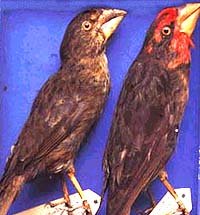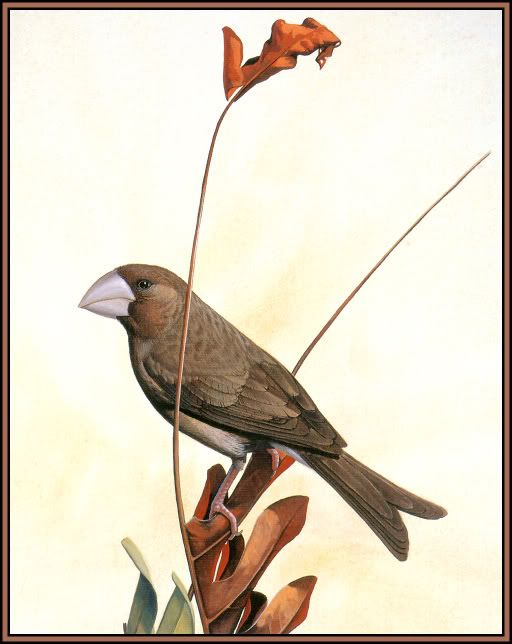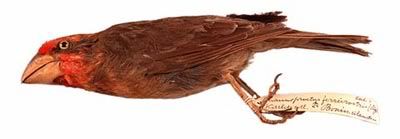|
|
Post by another specialist on Jun 3, 2005 7:14:52 GMT
 Some 2,000 species of Pacific Island birds about 15 percent of the world total have gone extinct since human colonization of the Pacific - including the Grosbeak that were found on Peel Island south of Japan. Then came an army of new residents: cats, rats, goats and dogs brought by whalers and other settlers. The vulnerable birds probably fed on the ground, and the rats in particular gobbled bird eggs and young. The last grosbeak was seen in 1828. www.spacedaily.com/news/life-02d.html |
|
|
|
Post by another specialist on Jun 3, 2005 7:16:54 GMT
|
|
|
|
Post by another specialist on Jun 3, 2005 7:17:50 GMT
 In the 1820s, these 8-inch finches (above) found on Peel Island south of Japan fed on fruits and buds in the forests of their volcanic home. Then came an army of new residents: cats, rats, goats and dogs brought by whalers and other settlers. The vulnerable birds probably fed on the ground, and the rats in particular gobbled bird eggs and young. The last grosbeak was seen in 1828. www.nwf.org/internationalwildlife/2000/deadbird.html |
|
|
|
Post by another specialist on Jun 14, 2005 11:10:17 GMT
|
|
|
|
Post by another specialist on Nov 6, 2005 17:18:48 GMT
 Gap in nature |
|
|
|
Post by sebbe67 on Dec 18, 2005 0:48:45 GMT
Bonin Islands Grosbeak Expelled by several mammal immigrants The German naturalist Friedrich von Kittlitz visited many Pacific islands. Several of the island species he collected later became extinct. As a result his name is now often associated with extinct birds, such as the Bonin Islands Grosbeak Chaunoproctus ferreirostris ( Vigors, 1828). He was the only naturalist to have seen this grosbeak alive. Von Kittlitz visited Peel Island in 1828. This island is part of the Ogasawara Islands, formerly known as Bonin Islands, south of Japan. The first Bonin Islands Grosbeaks were collected by sailors of the British navy vessel HMS Blossom, only one year before Von Kittlitz visited Peel. Von Kittlitz was able to collect several more specimens. In Von Kittlitz' description of the island he already noted the presence of feral pigs. A permanent settlement was founded in 1830 and goats, sheep, dogs and cats were aded to the pigs. This probably led to the extinction of the grosbeak. Like Kittlitz's Thrush, this bird was a ground dweller, and thus particularly vulnerable to predation by introduced mammals. The American naturalist William Simpson, who visited Peel Island in 1854, did not find any grosbeaks left. Bonin Islands Grosbeak The museum collection Only ten skins of the Bonin Islands Grosbeak are preserved in museums. The National Museum of Natural History possesses a male and a female, both collected by Von Kittlitz. The other specimens are in Berlin, Frankfurt, St. Petersburg, Tring and New York. www.naturalis.nl/300pearls/ |
|
|
|
Post by another specialist on Dec 30, 2005 20:36:42 GMT
from source above  |
|
|
|
Post by Carlos on May 31, 2006 17:37:05 GMT
Image modified from Fuller (2001)  Chaunoproctus ferreirostris Chaunoproctus ferreirostris |
|
|
|
Post by Carlos on Jun 24, 2006 10:38:57 GMT
|
|
|
|
Post by dysmorodrepanis on Jun 28, 2006 22:23:00 GMT
The American naturalist William Simpson, who visited Peel Island in 1854, did not find any grosbeaks left. I think the guy's name was Stimpson. "Simpson" seems to be a common mistake spread by a typo in the IUCN redlist. The Holst record ("1890") often found is wrong. First, it was 1889, and the reports referred to supposed birds seen in the 1880s, and second, the record was not Chichijima, but to Hahajima-retto (Hahajima group), probably Hahajima itself as the other islands in the group are fairly small. That would mean that a bird that was generally not willing to fly even if it had to pay with its life would, perpendicular to the prevailing winds, have flown the 35 kilometers south from Chichi to Haha. Not very likely. |
|
|
|
Post by another specialist on Jul 15, 2008 19:49:15 GMT
  Extinct birds : an attempt to unite in one volume a short account of those birds which have become extinct in historical times : that is, within the last six or seven hundred years : to which are added a few which still exist, but are on the verge of extinction (1907) |
|
|
|
Post by another specialist on Jul 25, 2008 6:21:17 GMT
 Extinct birds : an attempt to unite in one volume a short account of those birds which have become extinct in historical times : that is, within the last six or seven hundred years : to which are added a few which still exist, but are on the verge of extinction (1907) |
|
|
|
Post by Melanie on Jun 2, 2009 15:02:13 GMT
|
|
|
|
Post by koeiyabe on Dec 12, 2015 16:17:02 GMT
 "The Earth Extinct Fauna (in Japanese)" by Tadaaki Imaizumi (1986) |
|
|
|
Post by Sebbe on Jan 25, 2017 21:17:45 GMT
|
|
|
|
Post by surroundx on Jan 26, 2017 12:06:53 GMT
|
|